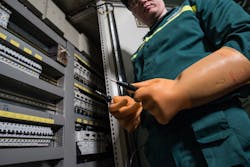When performing electrical work near energized parts, electricians must wear not only insulating rubber gloves and leather protectors, but also rubber sleeves in certain situations. To ensure that the rubber goods provide the proper level of safety for the field workforce, follow these three tips from the Occupational Safety and Health Administration (OSHA).
- Perform a visual inspection. Look for cuts, holes, tears or embedded objects before each use, according to OSHA. In addition, keep an eye out for changes in texture such as softening, hardening, swelling or becoming sticky or inelastic. If you see any signs of damage, remove the rubber goods from service immediately. The glove should be removed from its protector for any visual inspection. After that, the glove must be looked over for any gross defects. The user should then hold the cuff and flip the glove to trap air in it. With the air trapped, he or she can squeeze the glove to expand it for a detailed inspection. Only after doing that and finding no flaws will a craft professional put the gloves on and reinstall their leather glove protectors, says David Gilmer, a consultant for High-Voltage Power and Power Supply.
- Get the rubber goods electrically tested. Test rubber gloves regularly every six months, while testing rubber sleeves every 12 months. If they are used frequently, consider testing them monthly, states OSHA.
- Store the gloves and sleeves properly. Do not fold the gloves, and keep them away from direct sunlight, heat, and humidity. Also, be careful about exposing them to any chemical or ozone that could cause damage to the rubber goods.
For more information, check out OSHA's eTool on their website, which provides direct links to codes and standards.
Fischbach is a freelance writer based in Overland Park, Kan. She can be reached at [email protected].About the Author
Amy Fischbach
Amy Fischbach is a freelance writer, editor, and host of the Line Life Podcast based in Overland Park, Kan. Contact her at [email protected].
Sign up for our eNewsletters
Get the latest news and updates
